U.S. automakers are making gradual progress in electrifying their fleets, according to a presentation at the recent Automotive Futures 2022 propulsion strategies conference.
Automotive Futures surveyed some 50 powertrain experts in June and July, including nine OEMs and 18 suppliers, asking for their battery-electric and hybrid vehicle forecasts.
Following earlier surveys dating back to 2006, this year’s sampling of experts predicts BEVs will account for 12% of global passenger-vehicle demand in 2025 and 25% in 2030, while hybrids will grow to 28% and 33%.
BEVs accounted for 2.9% of the U.S. light-vehicle market and about 5.8% of the global market in 2021, according to Wards Intelligence data.
Meanwhile, the experts expect all categories of hybrids to grow in worldwide market share: plug-in hybrids to 6% in 2025 and 9% in 2030, full hybrids to 10% and 13%, and mild hybrids to 9% and 10%.
They expect the share held by spark-ignition vehicles in 2025 and 2030 to fall to 60% and 38%, respectively.
For light trucks, those surveyed predict BEV sales share will grow to 8% and 18% in 2025 and 2030, with hybrids (all types) rising to 17% and 26%. Meanwhile, the spark-injection vehicle share will fall to 66% in 2025 and 47% in 2030.
“The experts think that it is relatively likely that manufacturers will reach CAFE and emissions regulations with credits, but will be difficult without credits,” says Bruce Belzowski, managing director of Automotive Futures.
Credits include “off-cycle” credits for such things as high-efficiency lighting, aerodynamics, air conditioning efficiency, engine idle-stop systems and other advanced technology.
Looking at fleet credits and “credits earned,” a new data set kept by the research group, Tesla is the clear leader with 13.8 million mg of carbon-dioxide credits in 2020. It was followed by Honda at 2.9 million and Subaru at 2.0 million.
“All other manufacturers generated deficits in credits,” Belzowski says, “with Stellantis at -10.2 million.”
The group is expected to issue a final report for the year in December.
Meanwhile, Belzowski, says 50% of OEMs in the U.S. registered improvements in fuel economy in 2021 compared with 2020, based on preliminary EPA data. Asian brands were the market leaders, with Nissan posting the largest gain and General Motors the largest decline in 2021.
Sobering is the fact OEMs still are far from reaching 2026 federally mandated targets, which the Biden Admin. reset in May to 59.4 mpg (3.96 L/100 km) and 132 grams of CO2/mile for cars and 42.4 mpg (5.5 L/100 km) and 187 gm/mile for trucks.
In 2021, according to Belzowski, Nissan reported the lowest emissions and best fuel economy (all vehicle types) at 303 gm/mile and 29 mpg (8.1 L/100 km), down 8.7% and up 9.4%, respectively, from 2014 levels, when Automotive Futures first began tracking the data.
Sentra S’s 29/39 mpg city/highway helps put Nissan atop EPA fuel economy rankings.
Nissan was followed by Hyundai and Honda, tied for second, with Subaru, Kia, Toyota and Volkswagen next on the list.
General Motors, Stellantis and Ford came in at 415, 410 and 390 gm/mile and 21.5 mpg (10.9 L/100 km), 22.7 mpg (10.4 L/100 km) and 21.6 mpg (10.9 L/100 km), respectively, because of the larger presence of fullsize SUVs and pickup trucks in their fleets.
Although nine of 10 OEMs – all but GM – made improvements in emissions over the seven-year period, none achieved a 10% reduction in 2021. And in fuel economy, seven OEMs – all but GM, Ford and VW – registered gains.
In the car segment, the fuel-economy leaders in 2021 were Honda (32.1 mpg [7.3 L/100 km]), Toyota (31.6 mpg [7.4 L/100 km]), Kia (31.5 mpg [7.5 L/100 km]), Nissan (31.4 mpg [7.5 L/100 km]) and VW (30.7 mpg (7.7 L/100 km]). The leader in CO2 emissions was VW at 274 gm/mile. Next were Honda at 276, Toyota and Nissan at 280, and Kia at 281.
In the truck segment, Subaru was the leader at 28.3 mpg (8.3 L/100 km), followed by Honda at 26.0 mpg (9.0 L/100 km), Kia at 24.5 mpg (9.6 L/100 km), Nissan at 24.4 mpg (9.6 L/100 km) and Toyota at 23.3 mpg (10.0 L/100 km). The emissions leader was Subaru, scoring 313 gm/mile, followed by Honda (341), Kia (362), Nissan (364) and Toyota (381).





